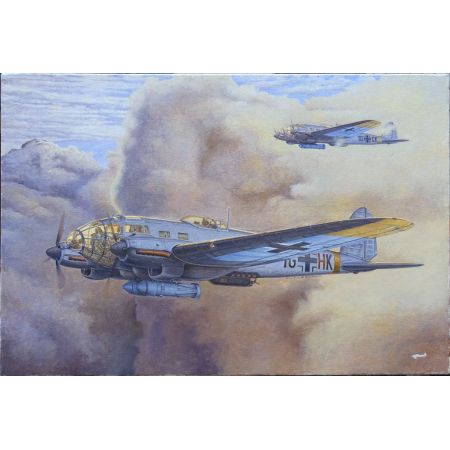Heinkel He 111H-16/H-20 1/144
 Paiements 100% sécurisés
Paiements 100% sécurisés








Roden 344 - Heinkel He 111H-16/H-20 1/144
Performances
Wingspan, m
22.6
Length overall, m
16.60
Height overall, m
4.0
Wing area, sq.m
87.7
Weight, kg
8,690
Takeoff weight, kg
14,000
Maximum speed, km/h
430
Range, km
2,000
Ceiling, m
8,500
Engines
2 х Jumo 211F-1
Capacity, h.p.
1,350
Arming
3000 kg bombs, 5хMG15 machine guns, 1xMG17, 1xMG 131
Crew, persons
5
In the mid-1930s, after Hitler’s rise to power and Germany’s effective departure from the restrictions of the Treaty of Versailles, the aircraft manufacturer Ernst Heinkel Fleugzeugwerke developed the successful He 111 twin-engine medium bomber. Initial versions of the design had an elliptical wing shape and a classic fuselage layout, but later versions such as the He 111P were built from the outset with a simpler and better engineered trapezoidal wing, as well as a new fuselage to improve aerodynamic performance and optimizing the location of the crew inside the aircraft.
In 1938, there was a problem with a shortage of the Daimler Benz engines installed on the He 111P and so the designers had to replace them with another type, the Jumo 211, while leaving the rest of the structure unchanged. This modification of the type was designated He 111H. At the beginning of 1939, the production of the He 111H first equaled that of the He 111P and then surpassed it. By September 1939, and the initiation of full-scale combat operations, the numbers of the H variant was already half of all available He-111 aircraft.
At the end of 1942, a modification of the He111H appeared which absorbed the best features of previous developments: the He111H-16’s powerful Jumo 211F-2 engines came from the He111H-6, and the enhanced armor protection of the most important components and units, and as in the He111H-11, carrying bombs inside the fuselage or on ETC 2000 external racks.
This version of the He111 was defined by the Luftwaffe management as standard, in that the manufacturer supplied additional equipment for the aircraft, which even in the field allowed it to be easily converted into various special-purpose modifications. The intensive combat service of the He111H-16 lasted from 1943 until the end of the war. Series production of the variant continued until the end of 1943, by which time a total of about 1,200 had been constructed.
In December 1943, series production began of the next major version, the He111H-20, which was generally based on the He111H-16, but from the beginning, these aircraft were considered solely as bombers for night missions. The armor was further strengthened and a new type of radio equipment was installed. In addition, the engines had a system of temporary power boost. Some aircraft were equipped with cable cutters. The defensive weaponry was also reinforced, and on external racks the aircraft could carry up to 2,000 kg of bombs of various weights. In total, by the end of 1944, 770 aircraft of this variant were produced, many of them being used almost until the last days of the war.
- Échelle
- 1/144
- Matière
- Plastique
- Type
- Avions & bombardiers
- Univers
- Militaire
- Produit
- Maquettes








feedback Signaler le commentaire